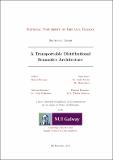| dc.contributor.advisor | Freitas, Andre | |
| dc.contributor.author | Barzegar, Siamak | |
| dc.date.accessioned | 2019-02-13T14:23:54Z | |
| dc.date.issued | 2019-02-13 | |
| dc.identifier.uri | http://hdl.handle.net/10379/14949 | |
| dc.description.abstract | Distributional semantics is built upon the assumption that the context surrounding a given word in text provides important information about its meaning (Distributional hypothesis). A rephrasing of the distributional hypothesis states that words that occur in similar contexts tend to have a similar meaning. Distributional semantics focuses on the construction of a semantic representation of a word based on the statistical distribution of word co-occurrence in texts. Distributional Semantic Models (DSMs) represent co-occurrence patterns under a vector space representation. In recent years, word embedding/distributional semantic models have evolved to become a fundamental component in many natural language processing (NLP) architectures due to their ability of capturing and quantifying semantic associations at scale. Distributional Semantics have been applied for different tasks in NLP area such as finding similar or related phrase/words, the computation of semantic relatedness measures, semantic relation classification and so forth. Distributional semantic models are strongly dependent on the size and the quality of the reference corpora, which embeds the common-sense knowledge necessary to build comprehensive models. While high-quality texts containing large-scale common-sense information and domain-specific information are present in English, such as Wikipedia, other languages may lack sufficient textual support to build comprehensive distributional models. Distributional Semantic Models are also often limited to semantic similarity/relatedness between two entities/terms with no explicit relation type. Often, it is not possible to assign a direct semantic relation between entities. This thesis seeks to analyse transportability aspects (Language and Domain) as and explores both coarse & fine-grained semantics for direct and indirect relation classification using a unified architecture (Indra) for developing language and domain independent DSM models with advanced (compositional) relation classification capabilities. | en_IE |
| dc.publisher | NUI Galway | |
| dc.rights | Attribution-NonCommercial-NoDerivs 3.0 Ireland | |
| dc.rights.uri | https://creativecommons.org/licenses/by-nc-nd/3.0/ie/ | |
| dc.subject | Distributional Semantic Model | en_IE |
| dc.subject | Word Embedding | en_IE |
| dc.subject | Natural Language Processing | en_IE |
| dc.subject | Deep Learning | en_IE |
| dc.subject | Lightweight Machine Translation | en_IE |
| dc.subject | Transportability | en_IE |
| dc.subject | Composite Semantic Relation Classification | en_IE |
| dc.subject | Engineering and Informatics | en_IE |
| dc.title | A transportable distributional semantics architecture | en_IE |
| dc.type | Thesis | en |
| dc.contributor.funder | Science Foundation Ireland | en_IE |
| dc.contributor.funder | Horizon 2020 | en_IE |
| dc.description.embargo | 2021-12-12 | |
| dc.local.final | Yes | en_IE |
| dcterms.project | info:eu-repo/grantAgreement/EC/H2020::IA/645425/EU/Social Sentiment analysis financial IndeXes/SSIX | en_IE |
| dcterms.project | info:eu-repo/grantAgreement/SFI/SFI Research Centres/12/RC/2289/IE/INSIGHT - Irelands Big Data and Analytics Research Centre/ | en_IE |
| nui.item.downloads | 59 | |


